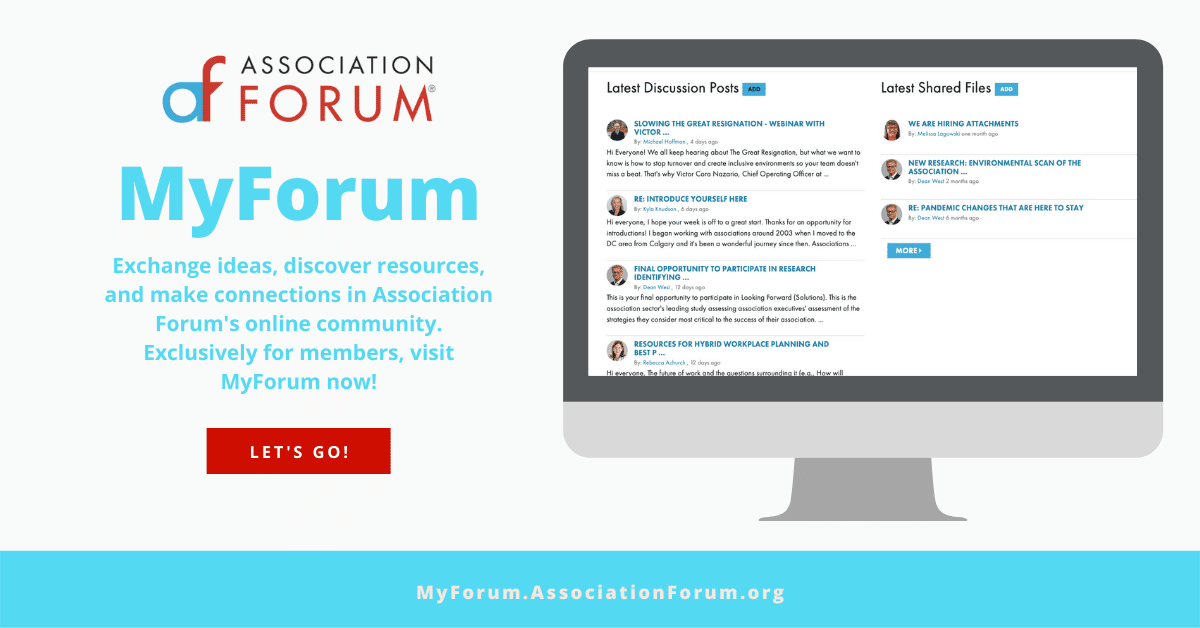How Your Online Community Can Shape the Member Experience

The online member community is changing. While in the past, associations may have just set up a Facebook or LinkedIn group and called it a day, they are now using more advanced and personalized methods of creating engagement between members—and then some.
According to the 2020 Engagement Trends Report by Higher Logic (a platform used by many association professionals interviewed for this article): “Branded communities are considered safer spaces than public social networks … people feel more comfortable showing vulnerability by asking questions.”
We spoke with several professionals about online communities that are flourishing. Here’s what we found:
Content Integration is Key
Associations are focusing on content integration as they build their online communities. Instead of treating their website and community as separate channels, they are integrating the content, as pointed out by Dina Lewis, CAE, founder of Content Forum, a content strategy community for association content professionals.
“What I love about community is the power of iterating,” Lewis says. She suggests tying in community content with the other content the association publishes to make it more valuable for members, as well as driving them to participate.
More Content is Being Created by Members
In successful online communities, members are the content contributors, they are the subject matter experts.
Forget the 90-9-1 rule. According to the Higher Logic trends report, “in small communities (under 5,000), 33% of community members are Creators and Contributors, which is 3x the community standard.”
Lewis has also found that community members are very willing to share: “In successful online communities, members are the content contributors, they are the subject matter experts.” She notes that member questions and quick posts get more responses than host-created content.
Tirza Austin, Senior Manager, Online Community at American Society of Civil Engineers (ASCE), echoes this as she points out that staff does not participate in their community (outside of monitoring for adherence to community guidelines): “Community-led programming is important,” Austin says. “Posts pertain to the work members do. They need this online community to help them answer questions in their work settings. That’s why it’s so organic and successful.”
Creating Community Around a Topic—as well as Engaging Year Round
HR Source launched their online community in February 2022, however, Director of Member Experience Julie Belloli said the planning process took almost a year as they determined how best to serve their members. They discovered that HR professionals needed a community built around programming, so they could engage with fellow program participants and create conversations around specific challenges.
In addition to their open forum, HR Source plans to launch a second community for their annual Altogether HR conference to start conversations, rally around session topics, provide networking opportunities and continue the conversations post-event and beyond.
Attracting and Empowering Younger Members
Research from Naylor’s Association Communications Benchmarking Survey suggests that more than half of associations admit they have trouble engaging young professionals, as well as customizing their communications for different member sub-groups.
ASCE saw this problem and launched “Career by Design,” a discussion forum geared toward students and younger members. Not only did they double their yearly goal in the first 6 months, but it’s still one of the most popular aspects of their community platform.
Austin attributes the success of the community to the team of group leaders who can prioritize what students and younger members are looking for and create specific topics to engage discussions. Austin points out that the “Career by Design” community has also paired well with their mentoring platform, giving young professionals a solid start to their careers.
HR Source’s current membership skews older than ASCE’s, but they have younger members in mind as they grow their new online community. Belloli mentions that one of their goals is to have a vibrant, welcoming community ready and waiting as younger members come into the association.
Making All Voices Heard—and Driving Advocacy
A data roundup from Personify shows that 66% of users join online communities to connect with people who have similar interests.
People also join to make their voices heard and support others. Lewis recommends that a community must feel inclusive and open to all: “Make sure you’re hearing the voices of all members.” She points out how important Content Forum was during recent times of crisis: “The community members could share how their organizations were reacting to the crisis, and get together to discuss communication challenges.”
The Association of Consultants to Nonprofits’ member-led, self-directed EMPOWER Groups rose out of a desire to bring together professionals serving the nonprofit community—but evolved into much more.
ACN member David Dow, a consultant with Schooley Mitchell, shares that the EMPOWER LGBTQ+ group grew quickly with members becoming engaged shortly after it was established. One of the benefits Dow points out: “You can tackle specific issues without making sure everyone is on the same page. You can have not just empathy, but share the lived experience.”
The EMPOWER LGBTQ+ group is also benefiting the greater association’s needs as it uses its momentum to drive advocacy and prioritize the association’s DEI initiatives. Dow also sees a common thread through the EMPOWER groups of paying it forward, for example, using their combined expertise to help someone in need (such as a young person launching a nonprofit).
Being There When They Need it Most
Research shows that people are more likely to invest in online communities during crisis, trauma, or major life changes. So it’s no surprise that the Anxiety and Depression Association of America (ADAA) saw an increase in engagement in their free peer-to-peer support groups for anxiety and depression during the pandemic.
The groups—with 70K English and Spanish-speaking users from around the world—saw a considerable bump in activity, says ADAA Deputy Director Lise Bram, with users discussing various mental health challenges they were experiencing. As Bram points out, “Many people couldn’t visit in-person or virtually with a mental health therapist, so the peer-to-peer communities provided crucial support when it was needed most.”
Providing Opportunity for Niche- and Micro-engagement
Tina Morton, Director of Member Engagement at American Society for Health Care Engineering (ASHE) shares how their online communities have formed to address members’ specific needs: “Our community serves a wide range of purposes from all-member engagement to bringing smaller groups of targeted groups together for a specific purpose.”
ASHE formed a COVID-19 Business Partners Resource Roundup community to help members find solution providers and resources to address issues around COVID-19 (the group currently has almost 8K members). And small, niche groups such as the ASHE sustainability and advocacy liaisons have also formed based on members’ needs.
ASHE also uses their online community to encourage volunteer micro-engagement. Morton says, “We want to engage as many members as possible and meet them where they’re at.” Rather than only offering full-time committee roles, the online community allows members to access micro-engagements, such as writing a story for Voices of ASHE, their member showcase.
Creating “Stickiness” that Aids Member Retention
HR Source’s online community is also a space to capture contacts they may only have one interaction with. Belolli points out that members often send a manager or supervisor to training programs rather than attending themselves, so the community provides another avenue for the association to reach out to them—and for members to see the value of their membership.
In fact, the 2020 Engagement Trends Report reported that “while people don’t continuously engage, they do remain part of the community. The data shows they’re sticking around [and] will come back to ask questions … [read] digests via email … sign up for an event or volunteer … come back to consume blogs.”
Belloli also shares a benefit of using a community platform that integrates with their CMS: they are able to see exactly how members are engaging. Considering the trends report showed that a community member who has been disengaged for a year is significantly less likely to renew, keeping an eye on your member community is crucial to member engagement.
Creating a Place for Support and Encouragement
Online communities have also evolved into a place for members to support and encourage each other. Melissa Swartz, Senior Manager, Community Engagement at ISACA shares how their association discovered increased engagement in their certification exam community.
ISACA group leaders post a question of the day from exam materials, how-tos for exam preparation, as well as best practices and responses to inquiries. After the exam, members come back to the community to celebrate passing the exam or getting approval of their application. People also rally around members who must retake the exam, encouraging them or helping them prepare for the next time. As Swartz says, their community is “a place for support, encouragement and celebration.”
As we’ve seen, associations are realizing they no longer want to be tied to a social network but rather have an owned and integrated online community that they can easily personalize. Today’s online community is welcoming, interactive and member-focused. As Belloli puts it: “It’s more about them. [Our community] shines a light on our members.”
Tags
Related Articles
The Emergency Nurses Association Utilizes Design Thinking to Reimagine its Awards Ceremony
In a prime example of intrapreneurship, the ENA utilized design thinking to innovate within the...
Report Reveals Strategies to Overcome Membership Decline
McKinley Advisors’ Membership Reset report provides a roadmap that association leaders can use to refocus...
Member Retention: More Than Just a Number
Learn how the AANA used humor and multichannel marketing to win back lapsed members.







